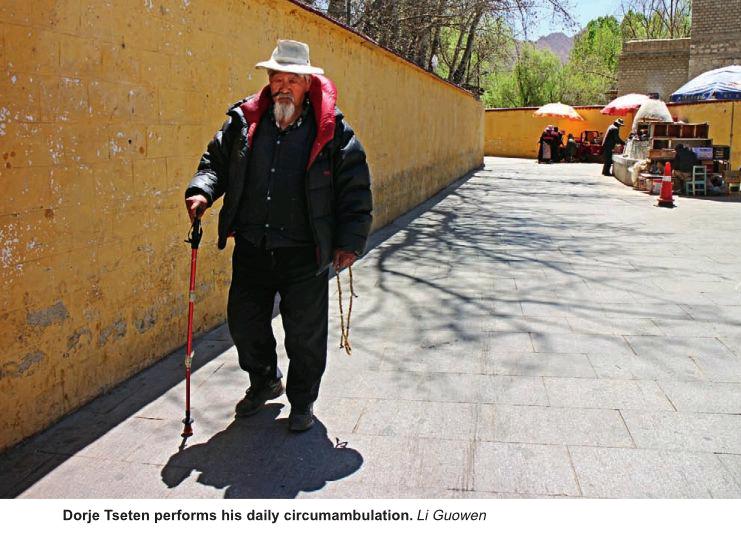A Homecoming
2014-09-27BystaffreporterLIGUOWEN
By+staff+reporter+LI+GUOWEN

I first met Dorje Tseten on his dai- ly circumambulation, the ritual of circling a Tibetan Buddhist holy site and praying, along Lingkhor, the sacred path in Lhasa, capital of Tibet Autonomous Region. While he no longer has the agility of his youth, the 84 year old insists on performing his prayer wheel ritual every day. On completion he takes the bus home. “I have the card for senior citizens that entitles me to free bus travel,” he said.
Dorje Tseten returned to Lhasa from a decades-long exile in 1999. He left Tibet in 1959 and lived for almost 40 years as a displaced person in India before coming back to his homeland 15 years ago. With his rich experience, the octogenarian is a true witness to pivotal changes in Tibetan history.
Dorje Tseten was from a “Tralpa,” or serf, family, who were forced to cultivate the land owned by the local government or serf owners. “My family and I were busy from dawn to dusk every day, but were still dirt poor,” he recalled.
In 1951, the Peoples Liberation Army(PLA) entered Tibet. Dorje Tseten had heard that the PLA was good to ordinary folk. “At that time, we heard rumors that many soldiers of the 18th Corps of the PLA had died during construction of the new road in Tibet and that the nobility did not offer any help,” Dorje Tseten said. But, in 1959 a riot erupted in Tibet under the incitement of a small group of nobles. In the panic and chaos Dorje Tseten and other ill-informed Tibetans fled China.
Destitution in India
Recalling the 1959 riot, Dorje Tseten says, “The society fell suddenly into disarray. Rumors that the Han people were on a mission to kill Tibetans filled the air, so many people chose to escape from Tibet. When we arrived in a refugee camp at the China-Indian border, we found that while the nobles there were well tended to by their servants, we ordinary people were ill-prepared. We had nothing to protect ourselves from the muggy weather, or deal with the different food and language. After living in the camp for several months with minimal support from the international community, many of the weak and poor died.”Having no money, the only way Dorje Tseten could survive was by exchanging his jewelry for food.
Aged 29, Dorje Tseten was a man in his prime during the period of his exile. Healthy and strong, he was recruited from the refugee camp by Indian officials to build new roads in a high altitude region. The working conditions were harsh and food was rationed. When the work was completed a military officer chose him to be his coachman. Dorje Tseten worked for the young master for two years in the officers hometown of Darjeeling. “ When the young master left for further education in Britain, he asked his father to find me a carpentry job in the family factory,” Dorje Tseten recalled. “A year later, I was employed as a carpenter by the ‘Tibetan Childrens Village, a school in Shimla, India.”endprint
In the following years he settled in Shimla, started a family and grew potatoes. Over the next few decades, Dorje Tseten opened a grocery store with his wife but continued doing carpentry. Despite having built a life for himself in Shimla, he nevertheless felt displaced and sorely missed his home in China. He and other uprooted Tibetans would try to glean news of Tibet from broadcasts,magazines and other media in order to connect with their hometown and relieve their homesickness.
In 1981, Dorje Tseten received a letter from his uncle in Tibet asking him to return to China to visit his family. His uncle had caught wind that Dorje Tseten was still alive from other Tibetan diaspora in India that had made home visits. The elder man asked a friend to send the letter to his nephew. Unfortunately, due to complex government procedures, when Dorje Tseten was finally granted permission for a family visit in 1985, his uncle had already died.
In 1985, Dorje Tseten finally set foot on Tibetan soil again after 26 years. In Lhasa he was shocked by what he saw:“No one needed to serve the nobles anymore. Everyone had his or her own house. They had jobs and salaries, and their children could receive education. People were free to have social lives outside of work. I was astonished and could not believe my eyes.”
A Long Way from Home
Dorje Tseten came from a large family. In 1985 when he finally met with his relatives again in Tibet, it had grown into a considerable clan. His family was thriving in good living conditions and persuaded Dorje Tseten to come back to China and live with them. He returned to India laden with various policy books lauding the benefits the Chinese government would offer to exiles and what the government were doing to improve the life of local Tibetans. He passed on his impressions of the new and improved Tibet to other exiled Tibetans in India, who, consequently, decided they would also try to go back to China.
As for Dorje Tseten, as soon as he got back to India, he constantly applied to return to China. However, time and again, the exile government turned down his application. “The officers always said we would all go back to Tibet together in just a few years,” Dorje Tseten said. “We had no choice but to wait.”
After his wife passed away, Dorje Tseten felt a stronger longing for his hometown. As the 20th century came to a close there was a favorable turn of events. Some exiles had traveled from India to Kathmandu, capital of Nepal, and successfully fled to Lhasa. This prospect excited Dorje Tseten. Aged 69, he sold his business in India and left with his 28-year-old son.endprint
The returning father and son opened a new grocery store near Tsemon Ling, a famous lamasery in Lhasa. With profits from their business, they were soon able to buy a flat in the center of Lhasa where three generations of the family lived together happily. Talking about the contrast between life in Shimla and Tibet, Dorje Tseten said emotionally, “In Shimla, we could not survive without working tirelessly. We had to make sure we had work everyday and keep working all the time; but here in Lhasa, things are much easier. We just need to pick up the phone and our shops shelves are filled with stock.”
He also admires the preferential policies accorded to the younger generation in Tibet today. His nephews and nieces can receive equal education and do not need to pay for tuition, and they can go on to do whatever they want when they leave school. “If I were younger, I would definitely want to contribute more to my country.”
Since the 1980s more than 2,000 exiled Tibetans have returned to China. They have enjoyed preferential policies in housing, land allocation, and animal husbandry. Some of them were elected to the regional Peoples Congress, the local legislature, and Chinese Peoples Political Consultative Conference, the local political advisory body.
Witnessing Progress
During his period in India, Dorje Tseten read reports on local media that it was not possible to build railways in Tibet. However, the Qinghai-Tibet Railway opened to traffic in 2006, and he was invited to take the train on its very first journey. “The ‘virgin voyage of the Qinghai-Tibet Railway broke the generally accepted verdict that railways could never be constructed on Tibetan terrain. Instead, a quick and convenient railway system for ordinary Tibetans was finally established.”
The dramatic changes and developments in Tibet go beyond the imagination of Dorje Tseten. “In the 15 years that I have been back in Tibet, the public facilities around me like schools, hospitals and roads have vastly improved. Tibet is living a dream.”
Public services in Tibet have grown fast in recent years, and the living conditions of Tibetans have constantly improved. Tibet is the first administrative region to achieve complete coverage of basic medical insurance, the new rural pension scheme and the minimum living allowance system among the local population. Dorje Tseten is a beneficiary of these government policies: “Every aspect of my life has been tended to very well since my return. My life is guaranteed by the state – I will neither starve to death, nor be left with huge medical bills if I get ill.”
Alongside economic and cultural rejuvenation of the region in the modern era, the traditional religion of Tibet still receives respect and protection. Prayer flags and mani stones engraved with Buddhist scripture are seen all over the autonomous region. Devout Buddhists with prayer wheels worship daily in the streets. “When I first returned, I was afraid my religious practice would be restricted,” Dorje Tseten said, “but all these worries soon vanished when I discovered the reality of daily life in Tibet.”
Nowadays, Dorje Tseten rotates his prayer wheel every day. He also likes following the news on the television and helping out in his sons shop. At night, his 11-year-old granddaughter wont sleep until she hears one of Dorje Tsetens bedtime stories. “In the twilight of my life, I am finally home, contented and satisfied. I am really happy now.”endprint
